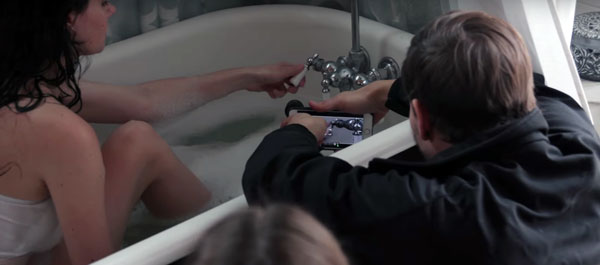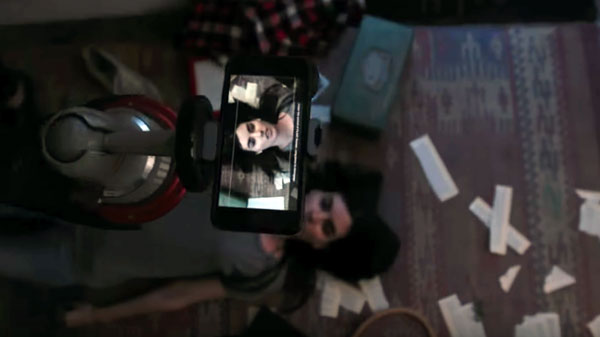How to Make an iPhone Film (according to Mango Street)
We’ve already written an article on how to make a film with a smartphone. But if you’re searching Google and using “iPhone” instead of “smartphone”, you might not have seen it. So I’ve made an article with iPhone in the title so it’s easier for iPhone users.
In fact, making a film with an iPhone is a little different to using an Android smartphone, like a Samsung S10, a Huawei P30 Pro or a Pixel 3. But go ahead and read our Ultimate Guide to Smartphone Filmmaking if you haven’t already. However, there are some differences.
People will try to tell you you can make your iPhone into a DSLR just by installing an app and adding some conversion lenses. Sure, you can get some shallow depth of field if you put a big lens on it.
Does it make your iPhone into a DSLR? Not in my opinion. Well, maybe a low budget one.
But that’s not a reason not to use one, anyway. I’ve recently shot 4 short films with Samsung smartphones. Famously, Sean Baker shot Sundance hit Tangerine with iPhone 5s. More recently still, Oscar Winning directors such as Steven Soderbergh and Claude Lelouch have used iPhones to shoot feature films.
The reason I use a mobile phone is because it’s easier, faster, more flexible, more spontaneous, lighter, and gives you more options when filming in public spaces (such as on trains or on the street).
How to get the most out of your iPhone (or indeed any smartphone) video
The fact is, you have one already and you carry it around in your pocket, even when you’re not thinking about shooting a film with it. This is not true with your DSLR or mirrorless camera.
So start thinking in a way that utilises this “camera at your fingertips” in the creative process of making a film.
Be spontaneous
I talked recently about when we shot a feature film using a camcorder. How we didn’t get permission for a cafe scene. We just showed up and asked to film. Then we all ran in and started filming on the spot.
With my mobile phone, we recently filmed in a pub without asking first. Thing is, everyone is filming themselves with their phones all the time. This is perfect camouflage for making an iPhone film in a public space.
Which is another thing. Shouldn’t extras in movies now be frequently filming or taking pictures of themselves? Surely a passing vlogger should be included in a normal, every day street scene. But that’s another subject…
Get into places other cameras can’t
And faster. This is Mango Street making their short film for Moment last year.
Try getting your DSLR plus lens into that space. With an iPhone it’s easy. And it wouldn’t take you more than a couple of minutes to set up that shot.
In other words, use the size and weight of the iPhone to get creative when shooting your film.
Here’s the whole behind the scenes movie:
The equipment they used was a whole set of Moment lenses, the Beastgrip DoF adapter and grip. They also used a Zhiyun Crane 2 stabilizer gimbal (this is a gimbal designed for DSLR use, which means it’s probably bigger than you need for an iPhone).
See how easy it is to get a high overhead shot with an iPhone. Although it looks like they used a jib arm, which really isn’t necessary.
iPhone film shooting tips
1. use an external microphone
If you have are recording voice while filming, then getting the microphone near to the speaker’s mouth is necessary to get good, clear audio.
The iPhone has great inbuilt mics good for ambient background sound. But if you want to use the inbuilt mics to record someone talking, you need to get the mics very close. Obviously, if you are also using the iPhone to film, then this isn’t going to be possible.
Sound is very important, especially with spoken audio where you want your audience to feel they can comfortably hear what people are saying.
Option A: mic connected to the iPhone
In a mobile journalist or interview situation, having the external microphone plugged directly into the iPhone is probably a preference. There are a number of affordable mics for use specifically with your mobile phone.
For later iPhone models you will need the Apple Lightning to 3.5 mm Headphone Jack Adapter for any mics which use a 3.5 mm jack.
For example, you can use a lavalier mic which clips onto the speaker, like this PowerDeWise clip on.
Another option is to use a handheld microphone. Check out our list of the best interview microphones.
Option B: a mic connected to a portable recorder
If you are making a film involving actors, then the best option is to use a microphone and portable recorder set up. This means the audio is recorded separately and needs to be synced to the video afterwards. This is how films with actors have traditionally captured audio over the last few decades.
You will need 4 items: a microphone (probably a shotgun mic), a cable, a portable recorder and a boom pole (if using a shotgun mic).
2. Use stabilizing equipment
Unless you want that shaky handheld look in your footage (and it’s a legitimate cinematography style), then look to use different methods to stabilize your iPhone. Because iPhones are smaller and lighter than other cameras, the equipment you use to make your camera more stable is also lighter (and therefore easier to carry around).
You don’t need a Zhiyun Crane 2 for your iPhone, you could use a smaller gimbal such as the highly popular Zhiyun Smooth 4 or the DJI Osmo 2. There’s other models too.
Gimbals are great because they allow you to get really interesting shots with a small piece of equipment. You can have your camera swoop down from as far as you can extend your arm (plus gimbal handle). To do this with a professional camera you would need $10000s worth of equipment and a trained crew to operate it.
Even if you want to have a handheld look, mounting your phone to some kind of grip gives you more control. You can also use a grip to mount a conversion lens.
Other than that, there’s a number of lightweight affordable tripods to use if you want to fix your camera in place. This is certainly good for interviews.
iPhone problems when used with a Gimbal
Inbuilt stabilisation in mobile phones is great for stills photography but less effective for video. In fact, it can even cause a problem when using a gimbal, as the 2 systems can work against each other. However a gimbal gives you much smoother footage when shooting video than either OIS or EOS.
“You may notice micro-shakes even in the best conditions, and that’s dependent on your smartphone. Sometimes the gimbal and the phone’s optical image stabilization (OIS) battle each other (the phone camera’s on-board OIS detects movement and tries to compensate). Turning off OIS is one solution, but sadly that’s not an option on some phones, like the iPhone.” TechRadar
One way to turn off OIS is to use a 3rd party app such as FiLMiC Pro. Of course FiLMiC Pro has tons of other advantages as well. Although it seems that even Filmic can’t switch off OIS in some iPhones.
Another option is to use a magnet to stop the OIS in your iPhone from working. Check this video below on how to do that.
3. Use a third party camera app
There are some great apps for iPhone which bring much more control when shooting a film. Apps such as FiLMiC Pro (used by Sean Baker, Steven Soderbergh, Claude Lelouch and many others) give you a lot of manual options. FiLMiC Pro is also compatible with some of the top gimbals.
There are other camera apps for iPhone filmmaking too. For iPhone, another one to look at might be MAVIS.
4. Understand the basics of cinematography
Whatever camera you use, you can really improve the quality of your film by understanding the basic principles of shooting film or video. Such topics as frame rate, shutter speed, ISO, white balance and focus will give you a grounding in the knowledge needed to get your film looking how you want it to look.
5. Study framing and shot creation
Watch movies and see how professional journalists or cinematographers use a camera to tell a story.
In journalism, the camera tends to be more functional. In other words, journalistic video allows what’s happening in front of the camera to tell the story, perhaps trying to be as neutral as possible.
In drama a cinematographer has more creative options. Remember, a film or video is a moving image. Therefore, not only does your story have a beginning, middle and end – each shot does too.
Where does your camera start, where does it move and where does it come to rest? That is essentially the basic method of constructing a shot.
Tip: Keep it simple. Sometimes a static shot is enough. Also, beware the temptation to move the camera too much, roving and roaming constantly. You may want to do this for creative reasons, but be aware it can be tiring to watch if the camera is constantly moving in such a wild way.
Show interesting stuff
Often, you will see new filmmakers share their videos, which are basically a series of wide shots, with lots going on in each shot.
But if you watch a news item or drama, wide shots are used very sparingly. Watching lots of wide shots is not engaging for an audience. You can use a wide to establish the setting. But really, my advice is to make up most of your video with close ups and medium close ups.
This means you will have to start to think about what you are filming and why it’s interesting to your audience. You will need to get closer to the subjects of these closer shots. Now think about how these shots connect together to tell a story (rather than unrelated random close ups).
So that’s the basics of using your iPhone to shoot a film. You might want to check out our recommended equipment in our official KIT LIST. You could also subscribe to our email list and receive all our new articles on how to use your mobile phone to shoot great films.
Eager to learn more?
Join our weekly newsletter featuring inspiring stories, no-budget filmmaking tips and comprehensive equipment reviews to help you turn your film projects into reality!
As an Amazon Associate I earn from qualifying purchases.
Simon Horrocks
Simon Horrocks is a screenwriter & filmmaker. His debut feature THIRD CONTACT was shot on a consumer camcorder and premiered at the BFI IMAX in 2013. His shot-on-smartphones sci-fi series SILENT EYE featured on Amazon Prime. He now runs a popular Patreon page which offers online courses for beginners, customised tips and more: www.patreon.com/SilentEye




I’m guilty of the last section, ‘Show interesting stuff’! I need to try and start thinking of stories. I’m going to Vegas and San Francisco next month for a holiday and I really want to shoot something that will be interesting to watch.
Look forward to seeing what you shoot Jon!